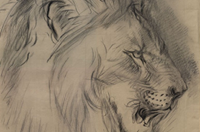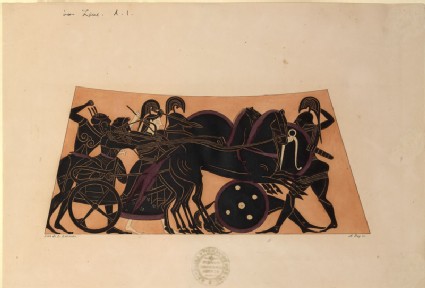Ruskin's Standard & Reference series (1872)
Exemplary works of art. In the catalogue of the Reference series, items marked 'M' are drawings "by my own Hand" (by Ruskin), P are photographs, E engravings and A by Ruskin's Assistant, Arthur Burgess.

Ruskin's Catalogues: 1 object
Show search help- Reference URL
Actions
Print of the Decoration on a Greek Amphora, showing Zeus, Heracles, Athena and Ares batting with Giants L. Letronne
-
Ruskin text
Above, Zeus Gigantomachos . -
Curator’s description:
Description
The lithograph shows four deities battling with two giants. The deities are, from the left, Zeus driving his chariot; Heracles, drawing a bow; Athena, holding a spear; and Ares, holding a spear and shield. One giant stands beside the heads of the horses drawing Zeus's chariot; another lies at their feet. The print reproduces the decoration of a black-figure amphora, then in the Grand-Ducal collection in Florence. It was plate I in the first volume of Lenormant and de Witte's "Elite des monuments céramographiques", published in 1844. It was presumably taken from Ruskin's copy of the work now preserved in the Ruskin Library (inventory no. 1996B2621), which is missing many of its plates.
The print was first catalogued by Ruskin in 1870, as no. 209 in the Standard Series, framed with another print from Lenormant and de Witte, of a red-figure illustration of Zeus and Nike; they formed part of a series 'arranged chiefly with the view of showing the change in Greek conception of deity'. It retained its number in the 1871 catalogue of the Standard and Reference Series but, by the time Cook and Wedderburn were compiling their edition of the catalogues (published in 1906), the frame had been moved to no. 191. Cook and Wedderburn note (XXI.45 n. 1) that it carried its original number (209) on the edge of its frame, but the new number (191) on the face. Presumably, it was easier to engrave and attach a new ivory label on the edge of the frame than it was to remove or gild over the painted number on the face.
According to Ruskin, the change in the ancient Greek conception of deity took place between the sixth and fourth centuries BC, and was marked by a development from conceiving of the gods as embodiments of physical forces to individual, characterised intelligences; from active to passive figures; and from grotesque to deliberately-selected beautiful depictions. At the same time, ceramic decoration changed from painting black figures on the red ground to painting a black background, letting the red ground show through in the figures themselves - though this soon led to careless execution. He believed the best vases were red-figure vases produced just after the transition (Catalogue of Examples, pp. 25-27; Standard and Reference catalogue, pp. 28-30).
Ruskin described the print as showing 'Zeus Gigantomachos [giant-fighter]', and it was presumably intended to show the development in images of Zeus.
-
Details
- Artist/maker
-
L. Letronne (active c. 1844) (printer)A. Rey (active c. 1844 - c. 1858) (lithographer)
- Object type
- Material and technique
- watercolour and bodycolour over lithograph on wove paper
- Dimensions
- 122 x 270 mm (stone); 236 x 349 mm (sheet)
- Inscription
- Recto, all printed, around the image:
bottom left: Lith de L. Letronne
bottom right: A. Rey sc.
Recto, in manuscript, top, towards the left, in ink: Ju Zeus. A.1. [the 'Ju' struck through]
Verso:
top left, in ink, written down the sheet: 1
bottom centre, the Ruskin School's stamp
- Provenance
-
Presented by John Ruskin to the Ruskin Drawing School (University of Oxford), 1875; transferred from the Ruskin Drawing School to the Ashmolean Museum, c.1949.
- No. of items
- 1
- Accession no.
- WA.RS.REF.191.a
-
Subject terms allocated by curators:
Subjects
-
References in which this object is cited include:
References
Ruskin, John, Catalogue of Examples Arranged for Elementary Study in the University Galleries (Oxford: Clarendon Press, 1870), cat. Standard no. 209
Lenormant, Charles, and Jean de Witte, Elite des monuments céramographiques: Matériaux pour l'histoire des religions et des moeurs de l'antiquité, 4 vols in 8 (Paris: Leleux, 1844-1861), vol. I, pl. I
Ruskin, John, Catalogue of the Reference Series Including Temporarily the First Section of the Standard Series (London: Smith, Elder, [1872]), cat. Reference no. 209
Ruskin, John, ‘The Ruskin Art Collection at Oxford: Catalogues, Notes and Instructions’, Edward T. Cook and Alexander Wedderburn, eds, The Works of John Ruskin: Library Edition, 39 (London: George Allen, 1903-1912), 21, cat. Reference no. 191
Location
-
- Western Art Print Room





